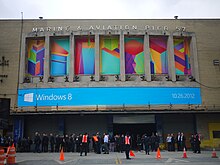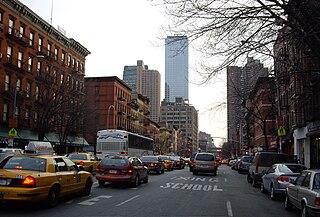
Hell's Kitchen, also known as Clinton, is a neighborhood on the West Side of Midtown Manhattan in New York City, United States. It is considered to be bordered by 34th Street to the south, 59th Street to the north, Eighth Avenue to the east, and the Hudson River to the west.

The Holland Tunnel is a vehicular tunnel under the Hudson River that connects Hudson Square and Lower Manhattan in New York City in the east to Jersey City, New Jersey in the west. The tunnel is operated by the Port Authority of New York and New Jersey and carries Interstate 78. The New Jersey side of the tunnel is the eastern terminus of NJ Route 139. The Holland Tunnel is one of three vehicular crossings between Manhattan and New Jersey; the two others are the Lincoln Tunnel and George Washington Bridge.

Chelsea is a neighborhood on the West Side of the borough of Manhattan in New York City. The area's boundaries are roughly 14th Street to the south, the Hudson River and West Street to the west, and Sixth Avenue to the east, with its northern boundary variously described as near the upper 20s or 34th Street, the next major crosstown street to the north. To the northwest of Chelsea is the neighborhood of Hell's Kitchen, as well as Hudson Yards; to the northeast are the Garment District and the remainder of Midtown South; to the east are NoMad and the Flatiron District; to the southwest is the Meatpacking District; and to the south and southeast are the West Village and the remainder of Greenwich Village. Chelsea is named after the Royal Hospital Chelsea in London, England.

Mulberry harbours were two temporary portable harbours developed by the British Admiralty and War Office during the Second World War to facilitate the rapid offloading of cargo onto beaches during the Allied invasion of Normandy in June 1944. Designed in 1942 and then built in under a year in great secrecy, within hours of the Allies successfully creating beachheads following D-Day, sections of the two prefabricated harbours and old ships, to be sunk to create breakwaters, were being towed across the English Channel from southern England and placed in position off Omaha Beach and Gold Beach.

North River is an alternative name for the southernmost portion of the Hudson River in the vicinity of New York City and northeastern New Jersey in the United States.

23rd Street is a broad thoroughfare in the New York City borough of Manhattan, one of the major two-way, east-west streets in the borough's grid. As with Manhattan's other "crosstown" streets, it is divided into its east and west sections at Fifth Avenue. The street runs from Avenue C and FDR Drive in the east to Eleventh Avenue in the west.

In geotechnical engineering, a caisson is a watertight retaining structure used, for example, to work on the foundations of a bridge pier, for the construction of a concrete dam, or for the repair of ships.
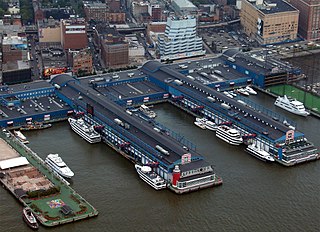
Chelsea Piers is a series of piers in Chelsea, on the West Side of Manhattan in New York City. Located to the west of the West Side Highway and Hudson River Park and to the east of the Hudson River, they were originally a passenger ship terminal in the early 1900s that was used by the RMS Lusitania and was the destination of the RMS Carpathia after rescuing the survivors of the RMS Titanic. The piers replaced a variety of run-down waterfront structures with a row of grand buildings embellished with pink granite facades.
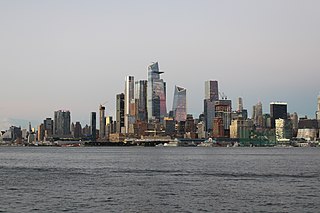
Hudson Yards is a neighborhood on the West Side of Midtown Manhattan in New York City, bounded roughly by 30th Street in the south, 41st Street in the north, the West Side Highway in the west, and Eighth Avenue in the east. The area is the site of a large-scale redevelopment program that is being planned, funded, and constructed under a set of agreements among the State of New York, City of New York, and Metropolitan Transportation Authority (MTA), with the aim of expanding the Midtown Manhattan business district westward to the Hudson River. The program includes a major rezoning of the Far West Side, an extension of the New York City Subway's 7 and <7> trains to a new subway station at 34th Street and 11th Avenue, a renovation and expansion of the Javits Center, and a financing plan to fund the various components. The various components are being planned by New York City Department of City Planning and New York City Economic Development Corporation.

Hudson River Park is a waterfront park on the North River that extends from 59th Street south to Battery Park in the New York City borough of Manhattan. The park, a component of the Manhattan Waterfront Greenway, stretches 4.5 miles (7.2 km) and comprises 550 acres (220 ha), making it the second-largest park in Manhattan after the 843-acre (341 ha) Central Park.
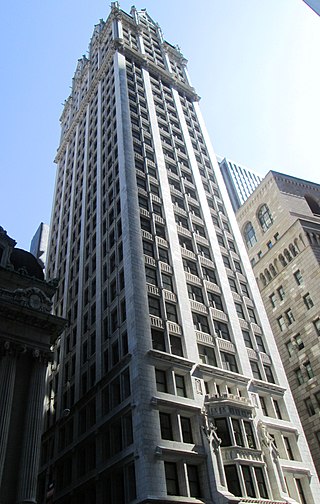
The Liberty Tower, formerly the Sinclair Oil Building, is a 33-story residential building in the Financial District of Manhattan in New York City. It is at 55 Liberty Street at the northwest corner with Nassau Street. It was built in 1909–10 as a commercial office building and was designed by Henry Ives Cobb in a Gothic Revival style.

The Whitehall Building is a three-section residential and office building near the southern tip of Manhattan Island in New York City, adjacent to Battery Park in lower Manhattan. The original 20-story structure on Battery Place, between West Street and Washington Street, was designed by Henry Janeway Hardenbergh, while the 31-story Whitehall Building Annex on West Street was designed by Clinton and Russell. The original building and annex are both at 17 Battery Place. Another 22-story addition at 2 Washington Street, an International Style building located north of the original building and east of the annex, was designed by Morris Lapidus.
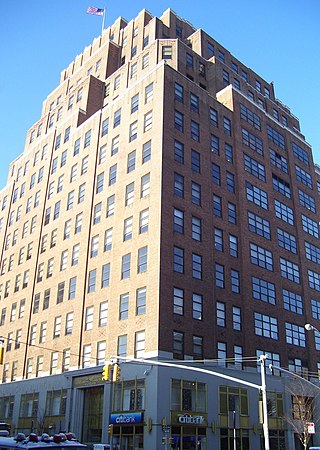
111 Eighth Avenue, also known as the Google Building and formerly known as Union Inland Terminal #1 and the Port Authority Building, is an Art Deco multi-use building in the Chelsea neighborhood of Manhattan, New York City. Fifteen stories tall and occupying an entire city block, it has 2.9 million square feet (270,000 m2) of floor space, more than the Empire State Building.

Pier 40 is a parking garage, sports facility, and former marine terminal at the west end of Houston Street in Manhattan, New York, within Hudson River Park. It is home to the New York Knights of the USA Rugby League, though it is primarily used by youth and high school athletics.

10 Hudson Yards, also known as the South Tower, is an office building that was completed in 2016 in Manhattan's West Side. Located near Hell's Kitchen, Chelsea and the Penn Station area, the building is a part of the Hudson Yards urban renewal project, a plan to redevelop the Metropolitan Transportation Authority's West Side Yard. Coach, Inc. is the anchor tenant. During planning, the tower was known as Tower C.

The Shed is a cultural center in Hudson Yards, Manhattan, New York City. Opened on April 5, 2019, the Shed commissions, produces, and presents a wide range of activities in performing arts, visual arts, and pop culture.

32 Old Slip, also known as One Financial Square, is a skyscraper in the Financial District of Lower Manhattan in New York City. Completed in 1987, the building has 36 floors and stands at 575 ft 0 in (175.26 m). 32 Old Slip was designed by the firm of Edward Durell Stone Associates for developer Howard Ronson and his firm HRO International. It is home to various office tenants, including a Convene convention center and the New York Regional Office of the United States Census Bureau. The ground floor houses the New York City Fire Department (FDNY) Engine Company 4 and Ladder Company 15.

Little Island at Pier 55 is an artificial island park in the Hudson River west of Manhattan in New York City, adjoining Hudson River Park. Designed by Heatherwick Studio, it is near the intersection of West Street and West 13th Street in the Meatpacking District and Chelsea neighborhoods of Manhattan. It is located slightly west of the Manhattan shoreline atop Hudson River Pier 55, connected to Hudson River Park in Manhattan by footbridges at 13th and 14th Streets. Little Island has three concession stands, a small stage, and a 687-seat amphitheater.

St. John's Terminal, also known as 550 Washington Street, is a building on Washington Street in the Hudson Square neighborhood of Manhattan in New York City. Designed by Edward A. Doughtery, it was built in 1934 by the New York Central Railroad as a terminus of the High Line, an elevated freight line along Manhattan's West Side used for transporting manufacturing-related goods. The terminal could accommodate 227 train cars. The three floors, measuring 205,000 square feet (19,000 m2) each, were the largest in New York City at the time of their construction.

Chelsea Waterside Park, formerly Thomas F. Smith Park, is a public park located at West 23rd Street between 11th and 12th Avenues along the West Side Highway in Chelsea, Manhattan, New York City. It was originally operated by the government of New York City under the New York City Department of Parks and Recreation. As of 2023 it is part of the Chelsea section of Hudson River Park and managed by the Hudson River Park Trust.





